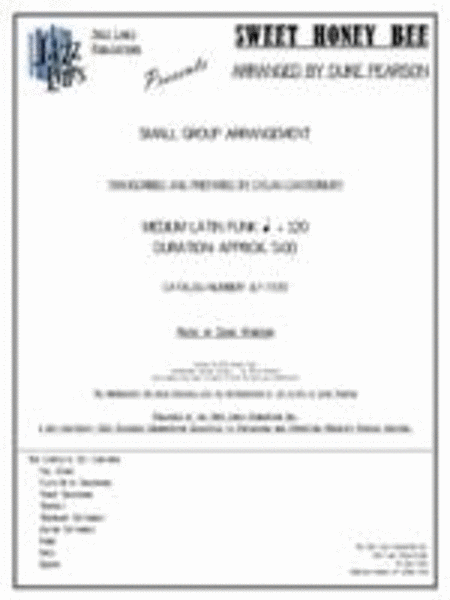Sweet Honey Bee
-
Ships in 2 to 3 weeks
Details
Description
SKU: JL.JLP-7330
Edited by Dylan Canterbury. Arranged by Duke Pearson. Jazz, Swing. Score and parts. Published by Jazz Lines Publications (JL.JLP-7330).Due to the surprise success of Lee Morgan’s The Sidewinder and Horace Silver’s Song For My Father, it became almost a given that any album released on the Blue Note label in the mid- to late 1960s would have at least one song attempting to recreate the commercial magic of the label’s two best selling hits. These efforts could be hit-or-miss at times; thankfully, Duke Pearson’s Sweet Honey Bee falls into the former category. In fact, the song was eventually covered by Lee Morgan himself on his Charisma album. On this particular version, the original Pearson recording from 1965, the melody on the A sections is stated by James Spaulding’s flute. Pearson’s piano accompaniment is the same throughout each statement of the melody, so it has been transcribed in full, as has the bass line. Mickey Roker’s drum groove is also fairly consistent throughout, and has been transcribed accordingly. The melody is simplistic, but undeniably catchy, with some well-timed riffs from the trumpet of Freddie Hubbard and the tenor saxophone of Joe Henderson. The interlude following the first melody statement provides the only real contrast in volume over the course of the tune’s melody, so dynamics should be carefully observed. Pearson’s piano fills are not complicated, but fit the mood of the performance perfectly. This is not the time for your piano soloist to whip out their hottest new licks; keeping things simple is of undeniable musical value here. After the interlude, the original recording featured one solo piano chorus from Pearson before a restatement of the melody, followed by a vamp and fade to serve as an ending. We have chosen to include chord changes for all instruments in order for the musicians to open things up as they see fit. Chord changes in the flute part are written in Eb for the convenience of your alto saxophone/flute doubler. In addition to providing a transcription of the original recording, included are alternate trombone and guitar parts to allow for ensemble flexibility. We sincerely hope you enjoy playing this tune as much as we enjoyed preparing it for you!
Ranges:
Trumpet: E5.

 Share
Share